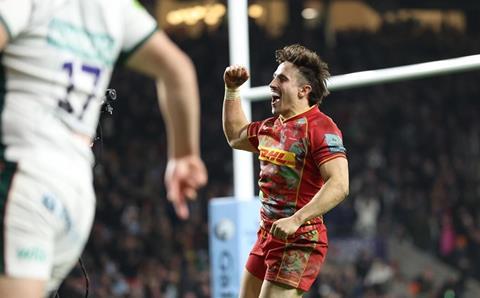Matt Millin-Brawn, director of strategy at Coolr, looks at how rugby has prioritised digital content

The full-time whistle has blown on this year’s Six Nations, and once again the Northern Hemisphere’s flagship rugby union tournament delivered an incredible viewing spectacle. France emerged from ‘Super Saturday’ as the overall winner - and while the final weekend’s viewing figures are yet to be released, the major turnout of at-home viewers in prior weeks reinforced its popularity.
At the time of writing, the England-France match attracted the most eyeballs, with six million tuning in across devices, giving ITV its biggest peak audience of the year. However, this looks rather paltry in the grand scheme of things - the final of Euro 2024 achieved a peak audience of 24.2 million across ITV and the BBC.
Terrestrial television, for so long the cornerstone of sports coverage, is struggling to maintain its position. Looking to take its place is digital media - and judging by Premiership Rugby’s standout year, it hasn’t flown entirely under the radar.
Viewership of the first six rounds of the 2024/25 Premiership season on TNT Sports and Discovery+ was up 30% compared to the previous year. Even more impressive is the league’s growing social media presence. Its YouTube engagement has increased by 15% year-on-year, with the league’s TikTok channel also thriving with over 170 thousand followers.
Rugby’s decision-makers aren’t alone in prioritising the growth of a digital-first footprint. Across the sporting ecosystem, the focus has shifted to creating more interactive and personalised experiences for fans. Whether it’s exclusive content, social media activations or influencer partnerships - brands that embrace this social shift can build stronger emotional connections with audiences.
Ripping up the game plan
Before rugby, it was Formula 1 that was transforming the sports media landscape. The seventh season of Drive to Survive debuted on Netflix at the beginning of the month. Despite receiving a lukewarm reception from critics in recent years, the series’ longevity is a testament to the way that its behind-the-scenes content resonates with its target audience.
By mirroring what works so well on social media - genuine behind-the-scenes footage that captures raw, unscripted moments - the show successfully creates a shared experience that keeps fans engaged.
F1 epitomises glitz and glamour: from the countless yachts that descend on Monaco every year to the sport’s brand partnerships, including LVMH’s 10-year deal to become a global partner from 2025. Similarly, Drive to Survive provides a polished viewing experience that peels back the curtain while keeping the sport’s mystique intact.
In contrast, Six Nations: Full Contact (also on Netflix) was axed before the second series even aired. Rugby’s answer to Drive to Survive was intended to launch the sport into the mainstream - but what transpired was a lacklustre affair that struggled to capture rugby’s inherent grittiness.
In reality, rugby’s unpolished nature has always been better suited to social media where real people, real stories and real moments are. Just look at the likes of James Haskell or Joe Marler, who have built social first personalities based on authenticity and a genuine POV on their respective worlds.
Authenticity keeps the scoreboard ticking
ITV’s highlights show is the perfect example of how brands can hit the gap and score points using social media. Gallagher Premiership Unleashed diverted away from relying ex-professionals as pundits, preferring instead to put three of rugby’s most popular influencers in front of the camera as hosts.
Each of these content creators is recognised as a credible voice within the rugby world. The ‘Squidge Rugby’ YouTube channel boasts over 250,000 subscribers, while ‘Ruckstar Lizzie’ has amassed four million likes on TikTok.
This earmarked the start of a new era of storytelling - one that was digital-first. These figures have an opportunity to act as the bridge between linear television and digital media, something which is made all-the-more important given the adoption of two-screen experiences.
Sports fans are no longer just watching matches on TV; they’re engaging in real-time conversations on social media. For brands and broadcasters, the question then becomes: how can they seamlessly insert themselves into these digital interactions at the peak moment?
The answer is simple. Leave everything out on the field. Use all of the assets at your disposal, whether that’s behind-the-scenes clips or influencer-created content. Perhaps even more importantly, listen to your audience - use their existing narratives as a springboard to drive engagement. This model has been used to great effect by The Good, The Bad & The Rugby podcast.
What began as a run-of-the-mill podcast series has evolved into a multimedia entertainment brand spanning books and live audience shows. But it’s not just the all-star lineup of Haskell, Mike Tindall and Alex Payne that attracts viewers en masse. Rather, it’s their willingness to tackle sensitive issues and participate in the conversations that rugby fans are already having on social media that truly captures attention. Nowhere is this more evident than in the no-holds-barred interview they had with Bill Sweeney, the RFU’s besieged CEO.
Regardless of whether a brand is targeting the sporting landscape or not, the takeaways from rugby’s new tactics remain the same. Authentic storytelling can elevate a sport, and the brands associated with it, into something much bigger. By aligning with the right content, brands can benefit from increased exposure, heightened emotional investment that turns customers into fans, and more organic integration into cultural conversations.

Matt Millin-Brawn is director of strategy at Coolr







No comments yet